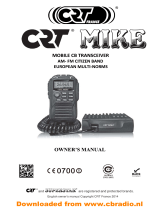Realistic trc-448 is a 40-channel mobile transceiver with a digital phase lock loop circuit that can synthesize each of the channel frequencies. It has a frequency range of 29.965 to 27.405 MHz, and uses a crystal control system. The transceiver has a power consumption of 40 watts, and can operate in temperatures ranging from -10°C to 50°C and humidity of 10 to 95%. It has a dynamic type microphone with PTT switch, and an operating voltage of 13.8 V DC. The transceiver also features a 205(W) x 60(H) x 260(D) mm size, and has a meter for displaying the TX power and signal strength.
Realistic trc-448 is a 40-channel mobile transceiver with a digital phase lock loop circuit that can synthesize each of the channel frequencies. It has a frequency range of 29.965 to 27.405 MHz, and uses a crystal control system. The transceiver has a power consumption of 40 watts, and can operate in temperatures ranging from -10°C to 50°C and humidity of 10 to 95%. It has a dynamic type microphone with PTT switch, and an operating voltage of 13.8 V DC. The transceiver also features a 205(W) x 60(H) x 260(D) mm size, and has a meter for displaying the TX power and signal strength.




















-
 1
1
-
 2
2
-
 3
3
-
 4
4
-
 5
5
-
 6
6
-
 7
7
-
 8
8
-
 9
9
-
 10
10
-
 11
11
-
 12
12
-
 13
13
-
 14
14
-
 15
15
-
 16
16
-
 17
17
-
 18
18
-
 19
19
-
 20
20
-
 21
21
-
 22
22
-
 23
23
-
 24
24
-
 25
25
-
 26
26
-
 27
27
-
 28
28
-
 29
29
-
 30
30
-
 31
31
-
 32
32
-
 33
33
-
 34
34
-
 35
35
-
 36
36
Realistic trc-448 is a 40-channel mobile transceiver with a digital phase lock loop circuit that can synthesize each of the channel frequencies. It has a frequency range of 29.965 to 27.405 MHz, and uses a crystal control system. The transceiver has a power consumption of 40 watts, and can operate in temperatures ranging from -10°C to 50°C and humidity of 10 to 95%. It has a dynamic type microphone with PTT switch, and an operating voltage of 13.8 V DC. The transceiver also features a 205(W) x 60(H) x 260(D) mm size, and has a meter for displaying the TX power and signal strength.
Ask a question and I''ll find the answer in the document
Finding information in a document is now easier with AI




































